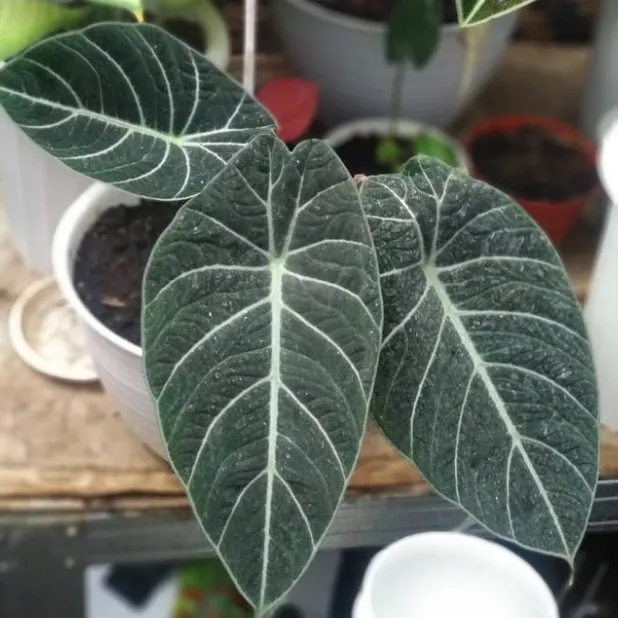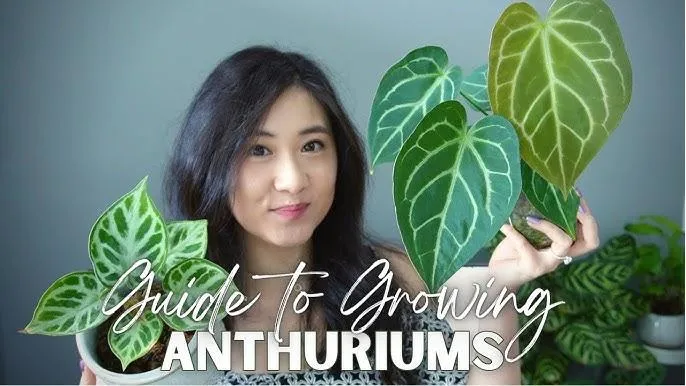Everything You Need to Know About the Beautiful Black Velvet Anthurium
The exotic black velvet anthurium is one of the most striking flowering houseplants you can grow. With its inky black spathes and vibrant red spadix, this tropical beauty stops people in their tracks. If you’re curious about black velvet anthuriums after seeing one, this comprehensive guide will answer all your questions.
What Is a Black Velvet Anthurium?
Black velvet anthuriums (Anthurium andraeanum ‘Black Velvet’) belong to the Araceae family. They’re epiphytic plants native to tropical rainforests in Central and South America. As the name suggests, their largest distinguishing characteristic is their near-black spathes or flower bracts. Underneath each spathe is a bright red or orange spadix – the central spike that holds the tiny flowers.
From my experience growing anthuriums, the black velvet variety puts on the most dramatic display. Their large, glossy spathes really pop against lush green leaves. Over time, a single spathe can reach 10 inches long. The brilliant contrast between the black and red makes for a truly unique decorative plant.
Care Requirements for Black Velvet Anthuriums
- Bright, Indirect Light: Black velvets love medium to high light but cannot take direct sun, which will scorch their leaves. East or west windows are ideal.
- Moist Soil: Keep the potting mix constantly moist but not soggy. These plants are epiphytic and prefer consistently humid conditions.
- High Humidity: Mist leaves daily and use a pebble tray or humidifier. Low humidity causes leaf edges to brown.
- Warm Temperatures: Thrive between 65-80°F. Cool drafts or temperatures below 60°F inhibit flower production.
- Nutrient-Rich Soil: Use an orchid or tropical houseplant potting mix. Feed monthly in spring and summer with a balanced liquid fertilizer.
Proper care results in bushy plants covered in spathes. However, anthuriums are fickle – environmental stresses like temperature fluctuations, drought, or low humidity quickly take their toll. Adaptability is key to success with black velvets.
Planting and Propagating Black Velvet Anthuriums
You can purchase black velvet anthuriums as rooted cuttings in four-inch pots. Replant them in a slightly larger container with fresh soil. Use a pot with drainage holes and good aeration.
In my experience, black velvets also propagate easily from stem cuttings. Simply remove four-inch sections with a node, let the cut end callus, and plant upright with the node buried in potting mix. Maintain humidity and they should root within 4-6 weeks. Once established, plants can be divided every 2-3 years in spring.
Don’t underestimate how fast black velvets grow once settled. Within a year, you may have a full basket of plants to share or start an anthurium collection! Propagation allows these beauties to multiply quickly.
Flowering and Care of Black Velvet Anthurium Blooms
Here are some tips on encouraging abundant black velvet anthurium flowers:
– Spathes typically bloom year-round in optimal growing conditions. However, they flower most prolifically in spring and summer with warmer temperatures and increased light levels.
– Cut flower spathes as they fade to encourage more buds to form. Use sharp, sterilized pruners or scissors.

– Pinch back new leaf growth periodically to divert energy into spathe production instead of vegetative growth.
– Remove any spent spadix remnants lodged inside spent spathes to prevent mold and rot issues.
– Prolong spathe lifespan by placing cut stems in water immediately after cutting. Change water every 2-3 days.
With good care, a black velvet plant becomes a living work of art decorated in dark flowers each season. Their striking blooms last for several weeks if cut properly.
black velvet anthurium Varieties
Beyond the classic black velvet, there are several other interesting anthurium varieties with different spathe colors:
– ‘Queen Cecile’: Spathes emerge deep burgundy and mature to a rich chocolate brown color.
– ‘ chocolate’: Nearly black flowers but with hints of dark brown/maroon.
– ‘Twilight’: Purplish-black spathes that appear almost blue in some lights.
– ‘Midnight’: True jet black flowers, perhaps the darkest of all.
– ‘Crimson’: Solid bright red spathes, a real showstopper that stands apart.

While the classic black remains a staple, connoisseurs enjoy collecting different anthurium varieties. Their spathe colors offer unique decorative appeal for any space.
Caring for Black Velvet Anthurium Cut Flowers
Cut black velvet anthurium blooms can last up to 3 weeks with proper care. Here are some tips:
– Trim stem ends under running water before placing in a clean vase.
– Add floral preservative or a 1⁄2-inch of lemon-lime soda to vase water, changing it every 2-3 days.
– Keep arrangement in a spot with bright, indirect light away from drafts.
– Monitor water levels daily and replace as needed.
– Remove any flowers or foliage that begin to wilt.
With some TLC, cut black velvet anthuriums can brighten up a home or office for weeks. Their unusual color combinations never cease to generate compliments. With care, cut blooms come close to matching the impressive longevity of the potted mother plants.
Inspired Indoor Décor with Black Velvet Anthuriums
From a design perspective, black velvet anthuriums pair well in many styles:
– Modern rustic – Use thick glass vases or basket arrangements on wood furniture.

– Tropical paradise – Float blooms in a shallow water feature or cluster plants on bamboo shelves.
– Moody bohemian – Hang plants in macrame hangers or group in dark ceramic pots.
– Eclectic maximalism – Incorporate anthuriums into a collection of patterned accessories.
– Serene spa vibe – Situate solitaires on marble surfaces or nestle in verdant ferns.
Their striking coloration naturally draws the eye. Black velvets elevate ordinary spaces into something striking and conversation-worthy. With some creativity, these plants shine in all styles of home. Their lush blooms are sure to spark joy all year long.
In conclusion, black velvet anthuriums make wonderful houseplants thanks to their unusual good looks and low maintenance needs. With the right care, these beauties reward growers with lush foliage and long-lasting blooms in an array of rich spathe colors. Their versatility also allows artistic arrangement and display. If you want to add an element of the tropics or intrigue to your indoor space, black velvet anthuriums are a top choice.
Factors to Consider When Choosing a Black Velvet Anthurium
| Trait | Details |
|---|---|
| Leaf Color | Dark burgundy leaves that are heart shaped. |
| Flower Color | White flowers with a red heart shaped spadix. |
| Light Requirements | Bright indirect light. Avoid direct sunlight which can burn the leaves. |
| Water | Keep soil moist. Water when top inch of soil is dry. Do not overwater. |
| Temperature | Prefers temperatures between 65-80°F. Can tolerate 55-95°F. |
| Humidity | High humidity between 50-70%. Mist leaves to increase humidity around plant. |
FAQ
-
What is a black velvet anthurium?
A black velvet anthurium is a beautiful tropical plant known for its dark heart-shaped leaves and dramatic red flowers. It likes warm and humid conditions.
-
How do you care for a black velvet anthurium?
To care for this plant, give it lots of sunshine and keep the soil moist but not soggy. You’ll also want to give it fertilizer every few months. They’re pretty low maintenance overall.
-
Do black velvet anthuriums bloom all year?
Basically no, these plants will bloom most during the spring and summer. Around fall and winter the flowers may stop for a bit. But if you keep them warm and watered, sometimes they’ll keep blooming on and off throughout the year.
-
Why are the leaves on my anthurium turning black?
If the leaves are turning black, it usually means too much sun or cold drafts. These plants like bright indirect light. The soil may also be staying too wet. Try moving it to a shadier spot and checking the drainage holes in the pot.

-
Is a black velvet anthurium poisonous?
Yup, all parts of the anthurium plant are mildly toxic to pets and kids if eaten. So you’ll want to display it somewhere up high or out of reach. But the fantastic red flowers sure are stunning to look at, even if you can’t touch!
-
Can black velvet anthuriums be grown indoors?
Yes indeed, as long as the conditions are warm and humid indoors. Provide lots of sunshine near a south or west window. Mist the leaves occasionally to mimic their tropical rainforest home. With a little TLC, they can thrive as a beautiful houseplant too.
-
What kind of soil do black velvet anthuriums like?
These plants prefer well-draining soil that retains some moisture but doesn’t get soggy. A good potting mix with some peat moss or bark in it works well. You can also add some perlite or gravel to the bottom of the pot to aid drainage. Does that help give the soil situation?
